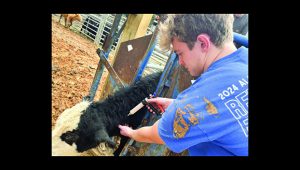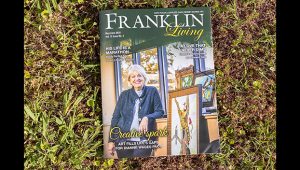Third generation stonecutter takes pride in continuing legacy
FRANKLIN LIVING SEPTEMBER-OCTOBER 2023
Story and photos by María Camp
For Russellville native Lee Todd, being a third-generation stonecutter means not only getting to do work he loves but also following in the footsteps of his father, Thomas Todd, and his grandfather, Odell Todd. As an employee in the finishing department of Alabama Stone in Russellville for the past 23 years, he is carrying on a family tradition he said he is proud to continue.
“They started quarrying stone from here in the late 1800s, using a different building, and I think our current building was built in the late ’20s or early ’30s,” Todd explained. “Right before World War II, they took all the stone machinery out and began making artillery shells for the war effort.”
Todd said his grandfather worked there making artillery shells. “He wasn’t old enough to be drafted,” Todd added. “When he got old enough, he joined the Navy. He turned 18 around 1942 or 1943, and he was on a destroyer until the war was over. When he came back home, they offered him his job back, and they were starting to make stone again by then. He retired in 1993 at 75 years old.”
Todd said it’s work all three have greatly enjoyed. “We have finished stone all over, including in other countries, and it’s very special to be able to drive by buildings and know you worked on it. We have a lot of interesting pieces all over the place. My grandfather worked on the big stone columns on the front of Valley State Bank in Russellville, and my father planed all the steps and windowsills and elements like that – all elements that are still there.”
Todd said the company’s stone is known for its quality. “Everybody wants our stone. Some of the other countries we’ve sent it to include China, Japan and Canada,” he added. “We’ve even done some elements for the White House.”
Plant superintendent Heath McKee said the company quarried about 1,272 blocks of limestone last year, representing about 32 million pounds of stone. “There are about 46 employees on site,” McKee said. “There are about seven in the quarry, down from around 100 initially, due to new technology. They used to use drills and blast, and now we have remote control saws, which have eliminated the need for that labor in the quarry.”
While Todd never worked with his grandfather, he worked with his father until about four years ago, when the latter passed away. To this day, Todd uses some of his grandfather’s tools, including chisels, pitching tools and a hammer, in doing his work. At Todd’s station at Alabama Stone, recent projects include column caps and steps for a mansion.
One aspect of his job he said he especially enjoys is cutting letters by hand. “When you learn how to do it, it’s easy,” he explained, “but it takes a bit to get it in your mind, and you have to figure out how it has to be, but I enjoy that. I like the hand pitching work.”
He learned all he knows about the craft by being taught on the job. Initially, he ran a machine for a couple of months and requested a transfer when an opening became available. “It’s the kind of work some people pick up and some don’t,” Todd said. “One of the men I work with, his dad worked here for 40-something years, and the one that works next to my station, that’s his son,” he added – he’s not the only one to carry on the tradition of being a stonecutter from one family generation to the next. Todd said another employee’s father was also a cutter for 40 years.
Todd said the company has worked on a lot of buildings at the University of Alabama in Tuscaloosa – and that includes his father, grandfather and himself. “My grandfather and my dad worked on some of the stone for the Paul Bear Bryant Museum on the campus,” he said, noting that was “way before” his time. “It’s quite the operation moving stone from one place to another. In the tunnel, what we call the quarry, they have front-end loaders with big forks on them with tires around 7 feet tall. Eighteen-wheelers are used to transport the finished stone from where we are to our customers.”
While the company works on pieces for large structures, they also work on smaller elements.
“Some of what we sent to Japan, there were probably close to a thousand really small pieces in it, but with other orders, we might put eight or 10 pieces or less on a truck, and it’s fully loaded,” Todd explained. “Another thing we do is cornice, decorative trim to go outside buildings.”
Todd said some pieces take as little as 30 minutes to finish, and others can take a week or longer. “Some of the buildings at Alabama, they’ll decide to remodel or add on because of storm damage or some other reason,” he added. “Some of the buildings are close to a hundred years old, and we’re redoing some stone that was originally done here, so I could be redoing some of the work that my grandfather did, and that’s kind of neat to think about.
“This is the only place in the world with consistent veining all the way through in the stone. Veining is kind of like the grain in wood,” Todd explained, noting that’s an element present because of how it naturally formed rather than anything they did to it.
“It’s a job you have to want to do,” Todd added. “I was always pretty good at art in school, and I’ve always enjoyed the more intricate work. I’m always proud of how the stone looks once it’s done, and there’s not too many people that still do this work in this way. It means a lot to be able to go see a building and know I had a hand in it.”
Todd is married to Anna Perez Todd. Both are Russellville High School graduates, and she is an English teacher at RHS. They live in Littleville with their children, Aria, 9, and Knox, 1.









